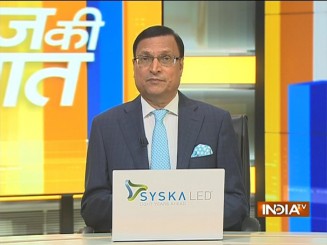 As the number of new Covid cases surges daily in a big spiral, all eyes are now set in India on when the current third wave of pandemic will reach its peak. Questions are also being raised when the spiral will taper off and normalcy will be restored. In my prime time show ‘Aaj Ki Baat’ on Monday night, we spoke to several leading experts about the current wave of pandemic. These are experts whose calculations during the deadly second wave during April-May last year were later proved correct.
As the number of new Covid cases surges daily in a big spiral, all eyes are now set in India on when the current third wave of pandemic will reach its peak. Questions are also being raised when the spiral will taper off and normalcy will be restored. In my prime time show ‘Aaj Ki Baat’ on Monday night, we spoke to several leading experts about the current wave of pandemic. These are experts whose calculations during the deadly second wave during April-May last year were later proved correct.
Experts believe that the current wave will end by the second week of March this year. The date being mentioned is March 10, after which normalcy may return. After examining data and current trends, the experts have made certain calculations which can give us a sense of relief. For example, Delhi, Mumbai and Kolkata, now the epicentres of pandemic, will return to normal soon, hopefully by the end of this month. This does not mean that we should lower our caution, because the pandemic will take its own time to subside. Experts have said, these three metros are yet to reach their peak. In other words, it means the number of cases will continue to rise.
Questions are also being raised whether the pandemic will spread during the campaigning, polling and counting in the states going to polls in February and March. Experts say, the number of cases in UP, Uttarakhand, Goa and Punjab will start decreasing by the end of January.
First, some facts. It takes hardly SIX seconds for a person to get infected with Omicron variant from an infected person. The virus is spreading very fast because of Omicron variant. It spreads SIX times faster than the previous Delta variant. Hopefully, the new variant is less deadly compared to Delta. More than 1.80 lakh new cases were reported across India during the last 24 hours. In one week the number of cases have jumped from 1.3 lakh to 7.8 lakhs, whereas during the second wave the number of cases had taken five weeks to jump from 1.3 lakh to 7.8 lakhs.
The speed with which Omicron variant is spreading has brought the positivity rate across India beyond 13 per cent. Positivity rate in Delhi, Mumbai, Kolkata and Bengaluru is above 25 per cent. The only relief is that hospitalization rate and death rate are now less compared to the second wave.
Experts believe the speed with which Omicron variant is spreading now, is going to slow down very fast within a short time period. IIT Kanpur professor Manindra Agrawal, who has studied the pandemic pattern closely, believes that the peak of the current wave will be reached either in the last week of January or the first week of February. At its peak, there may be requirement for 1.5 lakh hospital beds across India.
Delhi which logged 23,751 new cases on Saturday, reported 19,166 cases on Sunday because of less number of testing during the last 24 hours, but the positivity rate was at 25 per cent. Mumbai logged 13,648 new cases, Bengaluru 9,221 cases, and Kolkata reported 5,556 new cases.
According to the IIT Kanpur professor’s model, this situation may not remain constant. By January 15, the wave may reach its peak in Delhi, Mumbai and Kolkata. At its peak, Delhi may report 40-50,000 new cases daily. Mumbai may reach a peak of 35-40,000 new cases daily.
The most worrying part is that doctors, health workers and police personnel are getting infected on a large scale in all these metros. In Delhi alone, nearly 1,000 police personnel have been reported positive. At its peak, Delhi and Mumbai may require 13-15,000 hospital beds to treat patients.
Though night curfew and weekend curfew are being enforced strictly in Delhi, but in markets and shopping centres, the crowds are still there and many of the people are moving around without masks. Omicron variant spreads fast, but it is less lethal. In most of the cases, the infected persons do not show any symptoms, and there lies the problem.
The infected person does not know that he or she is positive, and should go into home isolation. In symptomatic cases, the usual symptoms are fever, pain in body, loose motion, cough and throat infection. Most of the patients recover within three days in their homes without taking any medicine. Only in cases of co-morbidities, where people are suffering from diabetes, heart, lungs and kidney related diseases, an infected patient may require hospitalization, as the virus spreads to different organs of the body.
In Delhi, there are 60,733 active cases presently and government has arranged 14,222 hospital beds. Only 1,999 patients have been hospitalized till now. 443 patients are in ICU. Only 503 patients require oxygen support. Nearly 88 per cent hospital beds in Delhi are presently lying vacant. In Mumbai, 34,960 hospital beds have been kept ready, out of which 7,432 beds are presently occupied. 30 per cent ICU beds now have patients. Compared to the second wave, there is no demand for medicines, oxygen and hospital beds. There are still crowds in Mumbai markets with many people refraining from using masks.